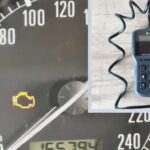For car enthusiasts and everyday drivers alike, having an OBD2 scanner can be incredibly useful for diagnosing car problems. However, when it comes to iPhones, the world of OBD2 scanners can get a bit tricky, especially if you’re looking for a budget-friendly option. Let’s dive into what you need to know to choose the right iPhone compatible OBD2 scanner.
One of the first things to understand is that “best” and “low cost” often don’t go hand-in-hand in the world of OBD2 scanners. Furthermore, iPhone compatibility introduces another layer of complexity, particularly with Bluetooth OBD2 readers. For reasons not always clear, Bluetooth OBD2 scanners can be challenging to pair and maintain a stable connection with iPhones.
If your primary goal is simply basic code scanning on a budget, an ELM327-based OBD reader or a similar knockoff version can do the job. These are generally low cost, but they typically don’t come with dedicated software. You’ll need to find a compatible app to use with them. Fortunately, there are online forums and discussions that can point you towards suitable iPhone OBD reader software, helping you navigate this potential hurdle.
However, if you’re looking for more advanced features and a smoother user experience, you might need to consider investing a bit more. The BlueDriver scan tool, for example, is known for its code scanning capabilities and its ability to provide repair recommendations tailored to specific vehicle makes and models. BlueDriver works exclusively with its own app and, while it’s a more expensive option, many users find it pays for itself by offering valuable, model-specific repair advice. It’s worth noting that while the BlueDriver reader enhances the experience, some reports suggest that you can even get repair reports from the BlueDriver app by manually inputting your vehicle details and error codes, even if you use a basic ELM327 reader.
For those interested in in-depth data monitoring, the OBDLink MX+ is another excellent, albeit pricier, choice. While BlueDriver also offers data monitoring, OBDLink MX+ is often preferred for its user interface and potentially faster data polling speeds. OBDLink MX+ also boasts enhanced code scanning that can decipher vendor-specific error codes, which can be incredibly helpful for accurate diagnoses. While these enhanced features were once add-ons, they are now generally included. However, keep in mind that even with advanced scanners like OBDLink MX+, you might still need to do some online searching to find the exact fix for a given error code, as the software may provide the code and a description but not the specific repair steps.
It’s crucial to remember that these OBD2 devices, including the ones mentioned, are primarily readers. They excel at reading and resetting error codes, but they are not designed to change vehicle parameters or perform more complex modifications. Both BlueDriver and OBDLink MX+ fall into a higher price bracket, around the $100 mark, but their value lies in ongoing updates for new vehicles and providing context around error codes, such as the frequency of occurrence on specific models and known solutions.
When researching OBD2 scanners, especially for iPhones, be aware that online reviews can quickly become outdated. The technology and software are constantly evolving, with updates frequently rolling out. Therefore, the information you find in older reviews might not accurately reflect the current capabilities and compatibility of a device.
Finally, a key point for iPhone users considering ELM327-based readers: Bluetooth versions often struggle with iPhone connectivity. For a more reliable connection with iPhones using ELM327, Wi-Fi versions are generally recommended. This is a crucial distinction to ensure your budget OBD2 scanner actually works with your Apple device.
